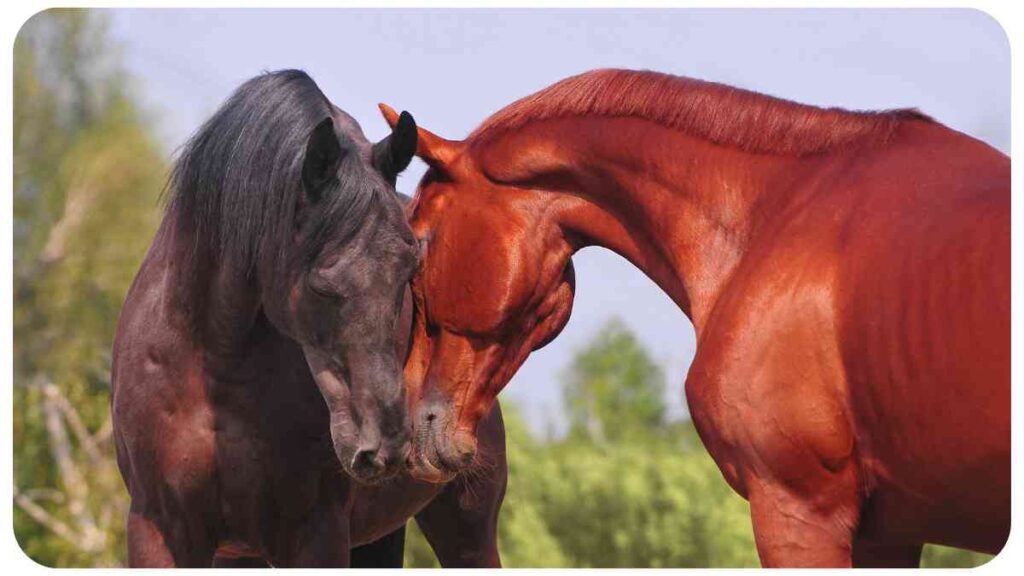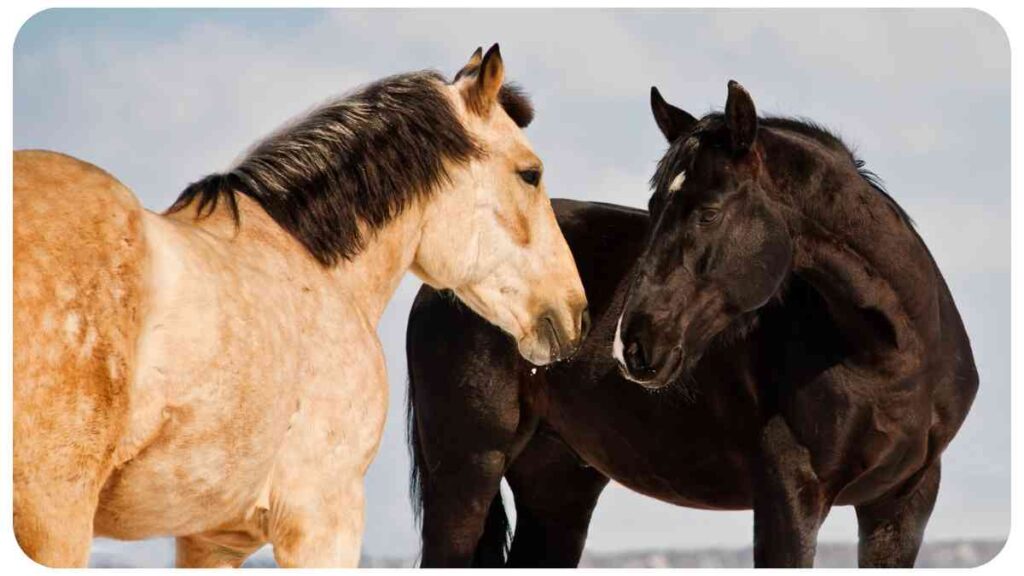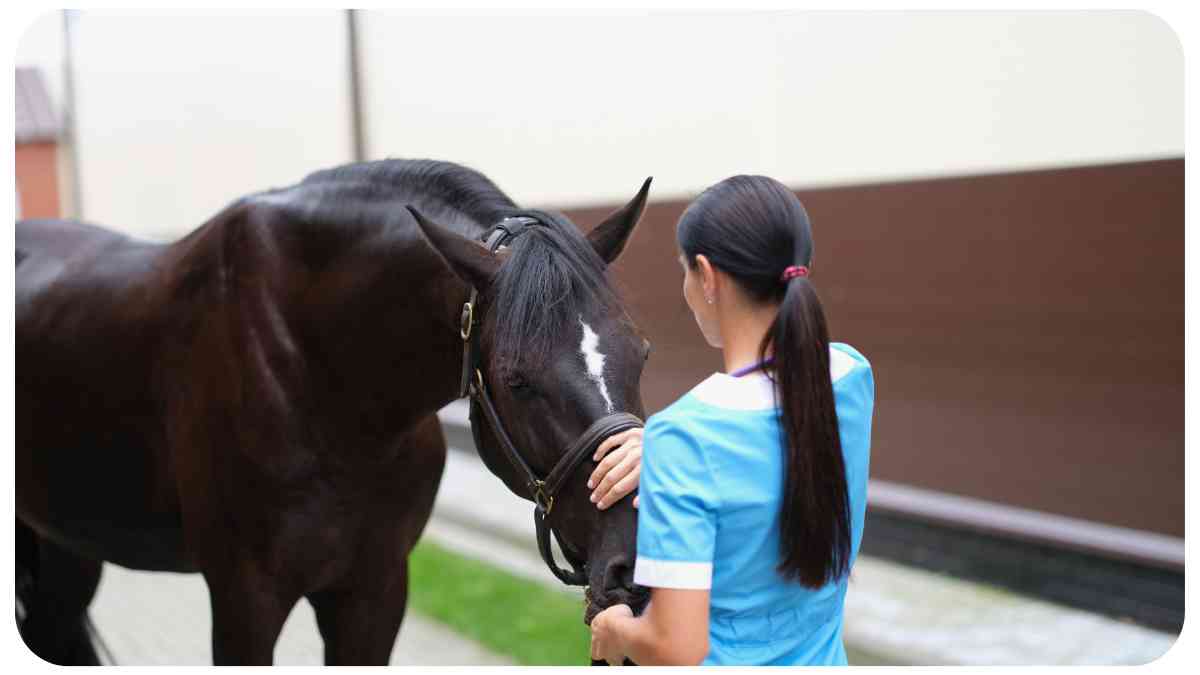Welcome to our comprehensive guide on teaching your horse to respond to voice commands. Many riders wonder if horses can understand and follow verbal cues. In this article, we’ll delve into the fascinating world of horse communication and explore the benefits, techniques, and challenges of training your horse to respond to voice commands.
With our expert tips and insights, you’ll be able to develop a strong bond with your equine companion and enjoy a more harmonious and efficient riding experience. So let’s get started!
| Takeaways |
| 1. Voice commands can enhance communication and safety in horse training. |
| 2. Consistency and reinforcement are key to teaching horses voice commands. |
| 3. Start with basic commands and gradually progress to more advanced cues. |
| 4. Safety should always be a priority during training sessions. |
| 5. Understanding and addressing common issues will help overcome training challenges. |
| 6. Seek professional guidance if needed, especially for more complex maneuvers. |
| 7. Building a strong bond with your horse is crucial for successful voice command training. |
| 8. Patience, persistence, and positive reinforcement are essential throughout the process. |
| 9. Voice commands are an additional tool and should not replace other forms of communication. |
| 10. Enjoy the journey and celebrate the progress made with your horse. |
2. The Power of Voice Commands
Voice commands are a powerful tool for equestrians seeking to enhance their communication with horses. Just as we humans convey emotions and instructions through speech, horses have their own language of whinnies, snorts, and neighs. By introducing voice commands, we can bridge the communication gap and foster a deeper understanding and connection with our equine partners.
When riding, it’s crucial to follow proper techniques for safety, such as using appropriate safety equipment. By mastering these techniques, you can enhance your riding experience while minimizing the risk of accidents.
3. Understanding Horse Communication

Before delving into voice commands, it’s crucial to grasp how horses communicate naturally. Not only do they rely on body language and subtle cues, but they also possess exceptional auditory capabilities. Horses are highly sensitive to tone, pitch, and volume variations in human speech, which provide them with valuable information about our intentions and emotions.
4. Benefits of Teaching your Horse Voice Commands
Training your horse to respond to voice commands offers a multitude of benefits. First and foremost, it improves safety by enabling clear instructions to be given from a distance. Voice commands also enhance precision and responsiveness during riding maneuvers, such as transitions and lateral movements. Additionally, voice cues contribute to the establishment of trust and a stronger bond between horse and rider.
5. Preparing to Train your Horse
Before embarking on voice command training, it’s essential to establish a solid foundation of groundwork and basic obedience. Your horse should respect your leadership and be responsive to physical cues before introducing vocal cues. Building a solid partnership based on trust and communication is key to successful voice command training.
Getting your horse accustomed to various stimuli is essential for their well-being. Learn effective strategies for desensitizing your horse to common fears, ensuring smoother rides and a more confident equine partner.
6. Getting Started with Voice Commands
To introduce your horse to voice commands, start in a controlled and familiar environment such as an enclosed arena. Begin with basic vocal cues and associate them with corresponding physical cues that your horse is already familiar with. Maintain a calm and confident demeanor, using clear enunciation and consistent voice patterns.
7. Basic Voice Commands for Horses
The initial set of voice commands should be simple and easy to remember for both you and your horse. Here are some commonly used basic voice commands:
Table: Basic Voice Commands
| Command | Explanation |
| “Walk on” | Instructs the horse to start walking |
| “Whoa” | Signals the horse to stop |
| “Trot” | Encourages the horse to trot |
| “Canter” | Initiates a canter or lope gait |
| “Back up” | Prompts the horse to take steps backward |
| “Stand” | Commands the horse to remain in place |
Remember to use these commands consistently and celebrate your horse’s successful responses with praise and rewards.
8. Advanced Voice Commands for Horses
Once your horse has grasped the basic voice commands, you can progress to more advanced cues. These commands require a higher level of training and understanding from your horse. Reinforce the foundation you’ve established and gradually introduce these commands for a more versatile riding experience. Here are some advanced voice commands:
Table: Advanced Voice Commands
| Command | Explanation |
| “Leg yield” | Prompts the horse to move sideways |
| “Counter canter” | Instructs the horse to canter on the opposite lead |
| “Half-pass” | Encourages the horse to move diagonally sideways |
| “Extend” | Signals the horse to lengthen the stride |
| “Collect” | Instructs the horse to shorten and collect the stride |
| “Turn on the forehand” | Prompts the horse to pivot on the forehand |
These advanced commands require refined coordination and understanding between you and your horse. Take your time, be patient, and reward your horse’s efforts as they progress through these advanced maneuvers.
Being knowledgeable about horse show etiquette is crucial for equestrians. Familiarize yourself with the dos and don’ts to ensure a respectful and successful experience in the competitive world of horse shows.
9. Reinforcing and Refining Voice Commands
Consistency and reinforcement are key components to reinforce and refine voice commands. Practice in various environments and scenarios to ensure that your horse understands and responds reliably, regardless of distractions. Here are some tips to aid in the reinforcing and refinement of voice commands:
Table: Tips for reinforcing and refining voice commands
| Tip |
| Consistency is crucial; use the same commands and cues every time |
| Gradually increase difficulty by introducing new environments, obstacles, or changes in gait |
| Provide regular intervals of repetition and practice to reinforce the commands |
| Use positive reinforcement such as rewards, praise, and petting when your horse responds correctly |
| Keep sessions short and focused to maintain your horse’s engagement and attention |
| Be patient and understanding; allow your horse time to understand and process the commands |
By implementing these tips and consistently working on your horse’s training, you’ll see steady progress and improved responsiveness to your voice commands.
10. Troubleshooting Common Issues
During the process of training your horse to respond to voice commands, you may encounter some common issues. Understanding these challenges and their solutions will help you overcome obstacles and continue making progress. Here are some common issues and their corresponding solutions:
Table: Common Issues and Solutions
| Issue | Solution |
| Inconsistent responses | Review your cues and ensure consistency in your voice and body language |
| Distraction-prone behavior | Gradually introduce distractions and reinforce focus through training |
| Lack of clarity or understanding | Simplify your commands and ensure consistent repetition and practice |
| Resistance or refusal to respond | Take a step back and reinforce basic cues before progressing further |
| Fear or anxiety towards vocal cues | Gentle desensitization exercises can help alleviate any fear or anxiety |
| Lack of motivation to respond | Vary your training routine, provide rewards, and make it enjoyable |
Remember, each horse is unique, and their responses may vary. Be patient, observant, and adjust your training methods as necessary to address any challenges that arise.
To build a strong foundation for your horse’s training, ground work plays a crucial role. Discover the importance of ground work and how it establishes a solid connection and understanding between you and your equine companion
11. Tips for Training Horses with Voice Commands

As an experienced equestrian, I’ve gathered some valuable tips and insights to help you in your journey of training horses with voice commands. Drawing from my own encounters with horses, here are some expert tips for successful voice command training:
Table: Expert Tips for Training Horses
| Tip |
| Start with groundwork: Establish a strong foundation of respect and obedience through groundwork before introducing vocal cues. |
| Use a clear and confident voice: Enunciate your commands clearly and use a confident tone to convey your expectations effectively. |
| Keep training sessions short and focused: Horses have shorter attention spans, so keep the sessions concise and targeted for maximum engagement. |
| Reward and reinforce: Positive reinforcement through praise, treats, or pats on the neck reinforces the correct response and motivates your horse. |
| Be consistent: Use the same commands, cues, and body language every time to avoid confusion and create a predictable training environment. |
| Progress gradually: Introduce new commands and maneuvers gradually, building upon the foundation and skills that the horse has already mastered. |
| Be patient and persistent: Rome wasn’t built in a day, and neither is a well-trained horse. Consistency, persistence, and patience are key. |
By following these expert tips, you’ll be well-equipped to train your horse effectively and develop a strong bond based on clear communication and trust.
12. Safety Considerations
While training your horse to respond to voice commands can be an exciting and rewarding experience, it’s essential to prioritize safety throughout the process. Here are some safety precautions to keep in mind:
Table: Safety Precautions for Training Horses with Voice Commands
| Precaution |
| Wear appropriate safety gear: Always wear a helmet and proper riding attire to protect yourself in case of accidents. |
| Work in a controlled environment: Begin training in a secure and enclosed area to minimize the risk of accidents or escapes. |
| Maintain a respectful distance: Be mindful of your horse’s personal space and maintain a safe distance to prevent accidental kicks or bites. |
| Use a calm and assertive approach: A calm and confident demeanor helps create a positive atmosphere and reduces the risk of unpredictable behavior from your horse. |
| Avoid harsh punishments: Train with positive reinforcement rather than punishment, as harsh methods can lead to fear or aggression in your horse. |
| Know your horse’s limits: Understand your horse’s physical abilities and limitations to avoid pushing them too far, which can result in injury. |
| Be aware of your surroundings: Stay vigilant and aware of potential hazards or distractions in your training environment that could startle or spook your horse. |
| Seek professional guidance: If you encounter difficulties or are unsure about any aspect of training, consult a professional trainer for assistance. |
By prioritizing safety and taking these precautions into account, you can mitigate risks and ensure a safe training experience for both you and your horse.
If you are a passionate equestrian seeking new adventures, explore this guide to equestrian tourism. Discover the best global destinations for exhilarating horseback riding experiences that will create lifelong memories
13. Conclusion
Congratulations on completing this comprehensive guide on training your horse to respond to voice commands. Through an understanding of horse communication, the benefits of voice commands, effective training techniques, and troubleshooting common issues, you’re well-equipped to embark on this exciting journey.
Remember, building a strong bond with your horse takes time, patience, and consistent effort. Utilize the power of voice commands to enhance your communication, safety, and overall riding experience. With practice, reinforcement, and a deep understanding of your horse’s individuality, you’ll be amazed by the results.
So, go ahead, enjoy the process, and watch as your horse responds to your voice cues with understanding and obedience.
Happy training!
Further Reading
Here are some additional resources for further reading on training horses with voice commands:
- Top 10 Voice Commands and How to Use Them: This article provides a comprehensive list of the top 10 voice commands for horses and offers insights into their proper usage.
- Horse Commands: Voice vs. Leg: Explore the differences between voice commands and leg cues when communicating with your horse. This resource discusses the benefits and considerations of each method.
- Leg Pressure vs. Voice Commands: Dive into a forum discussion exploring the effectiveness of leg pressure versus voice commands in horse training. Gain insights from the experiences and perspectives shared by fellow horse enthusiasts.
FAQs
Here are some frequently asked questions about training horses to respond to voice commands:
Can all horses be trained to respond to voice commands?
Yes, most horses can be trained to respond to voice commands. Just like humans, horses have the ability to learn and understand verbal cues with proper training and consistency.
How long does it usually take to train a horse to respond to voice commands?
The duration of training depends on various factors, including the horse’s temperament, prior training, and your consistency in reinforcing the commands. On average, it can take several weeks to a few months of consistent practice for a horse to respond reliably to voice commands.
Do voice commands replace other forms of communication, such as leg cues?
Voice commands can serve as an additional tool for communication with your horse, but they should not replace other forms of cues, such as leg or rein aids. It’s important to maintain a well-rounded training approach that includes a combination of voice, body language, and physical cues.
Can I teach my horse new voice commands at any age?
While it’s generally easier to teach horses new commands when they are young and more receptive to learning, horses of any age can learn and adapt to new voice commands. Patience, consistency, and positive reinforcement are essential regardless of the horse’s age.
What if my horse doesn’t respond to a voice command?
If your horse doesn’t respond to a voice command, it could be due to various reasons, such as confusion, distractions, or a lack of understanding. In such cases, go back to basics, reinforce the command with familiar cues, and gradually work on building your horse’s understanding and responsiveness.
Remember, each horse is unique, so it’s essential to tailor your training approach to your horse’s individual needs and abilities.

Hi there! My name is Hellen James, and I’m a horse riding expert. I’ve been riding horses since I was just a kid—and it’s been my passion ever since. But getting started with horse riding can be overwhelming. There’s so much to learn! If you’re looking for a way to get started and make sure you’re doing it right, I’m here to help.


